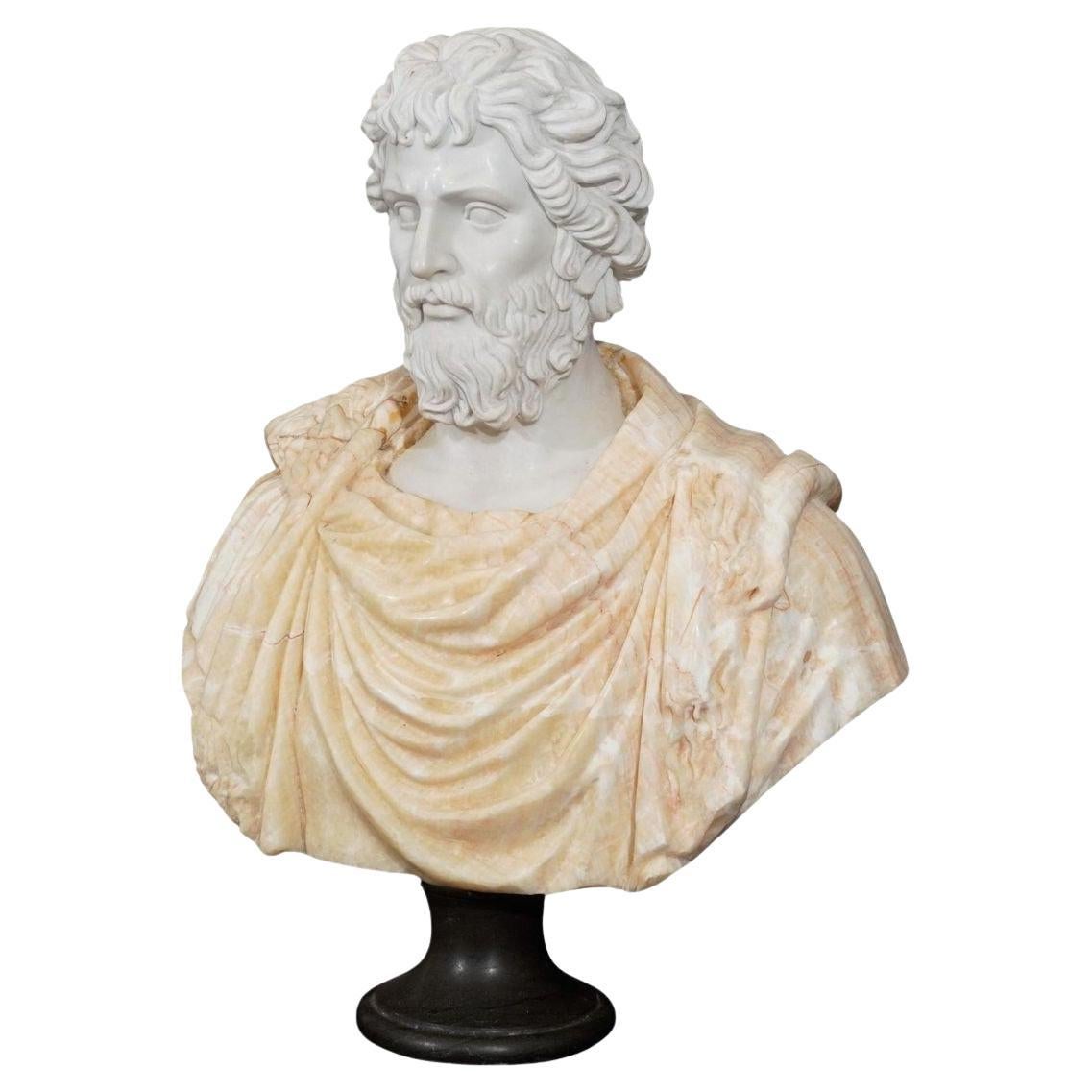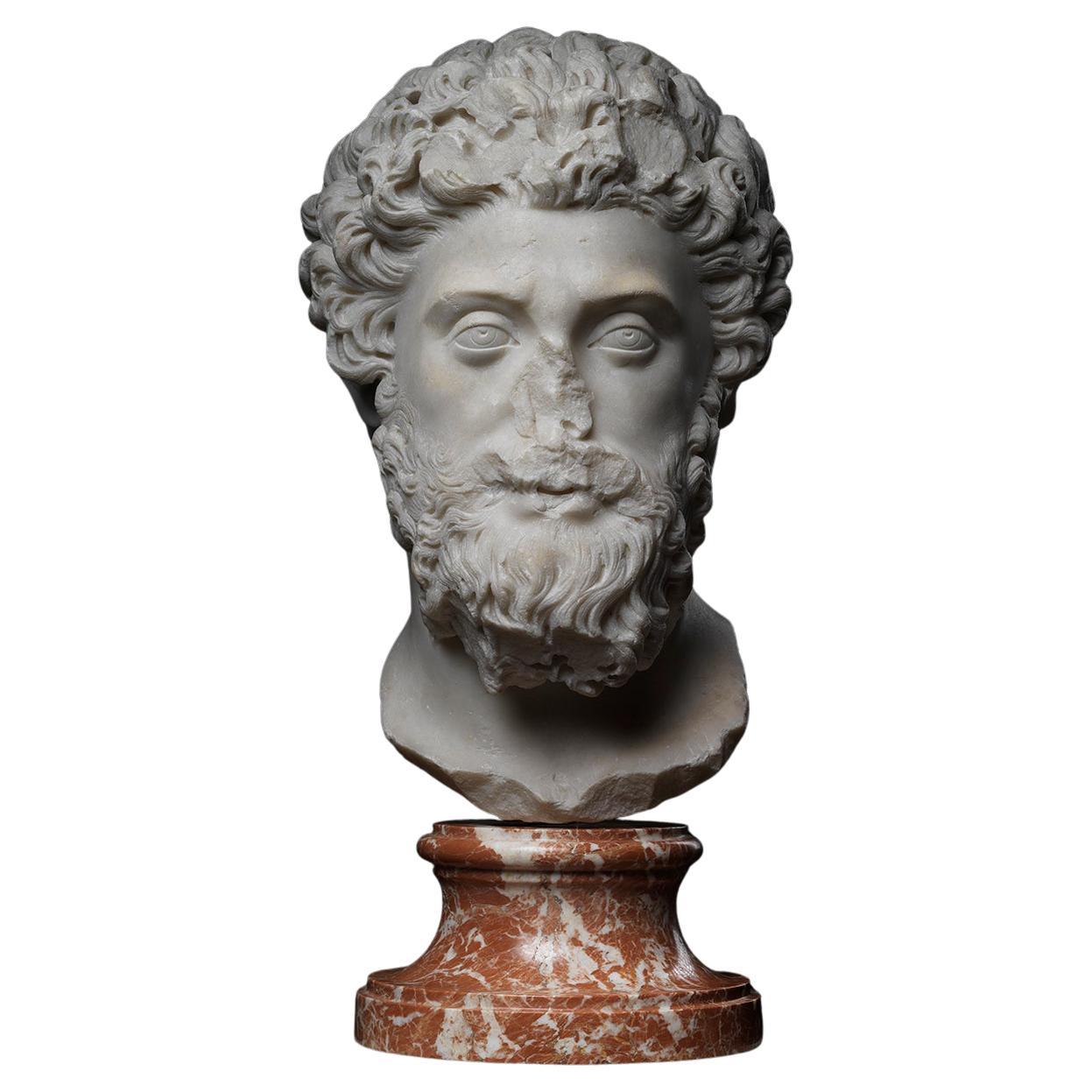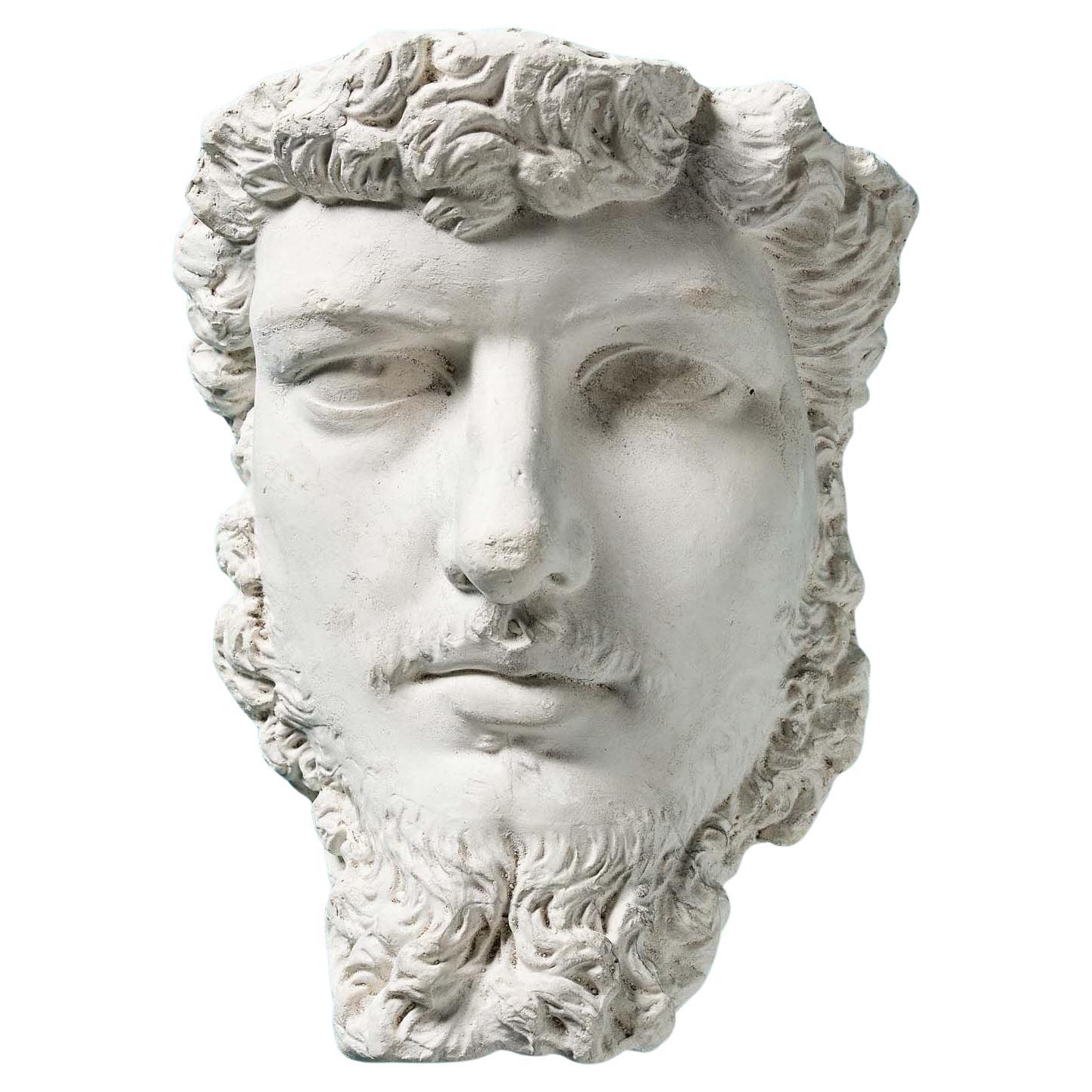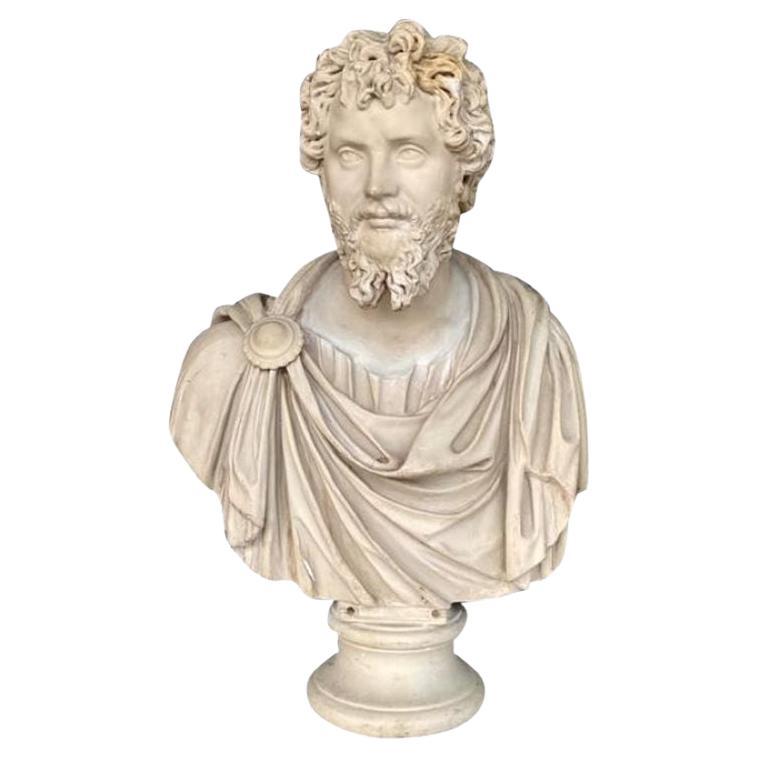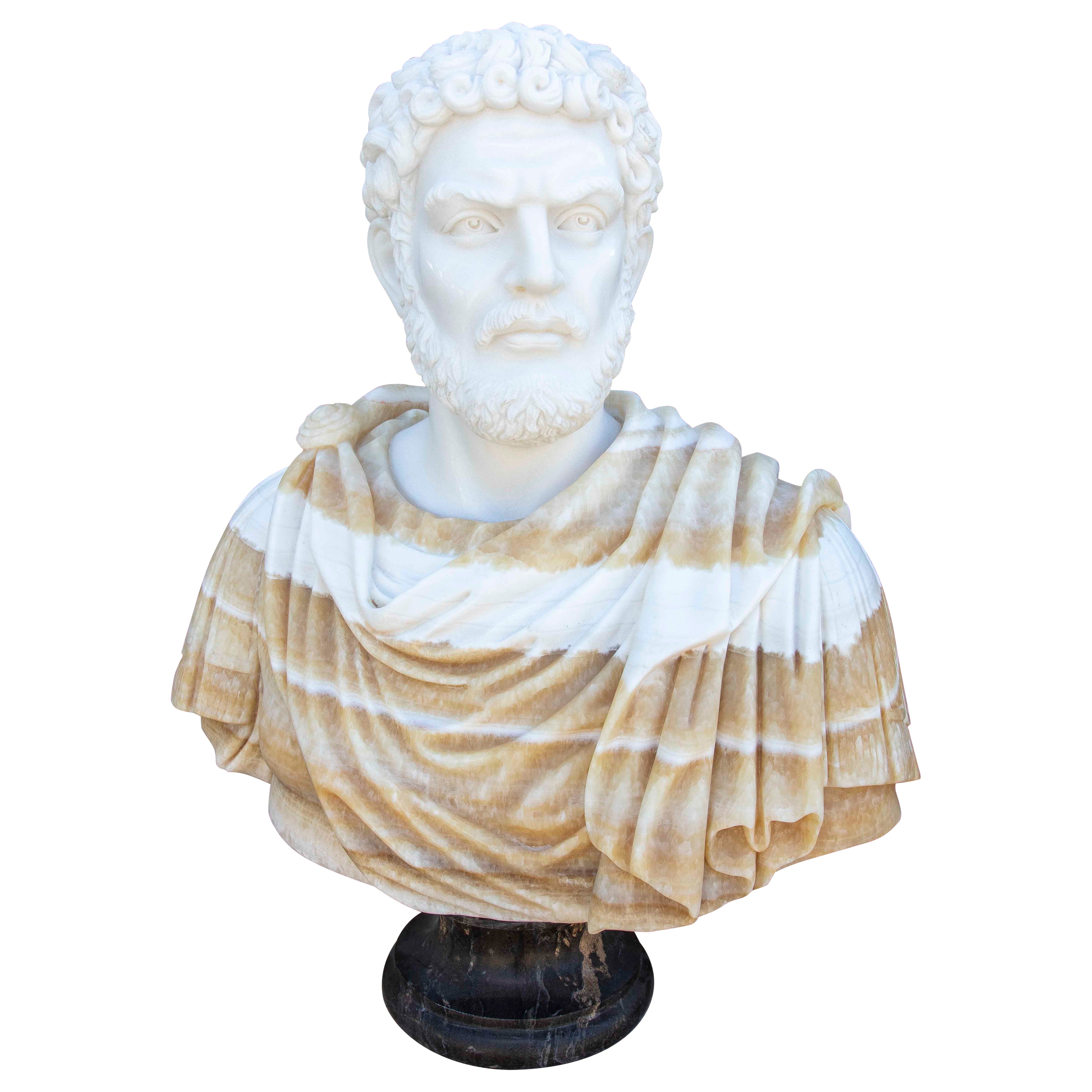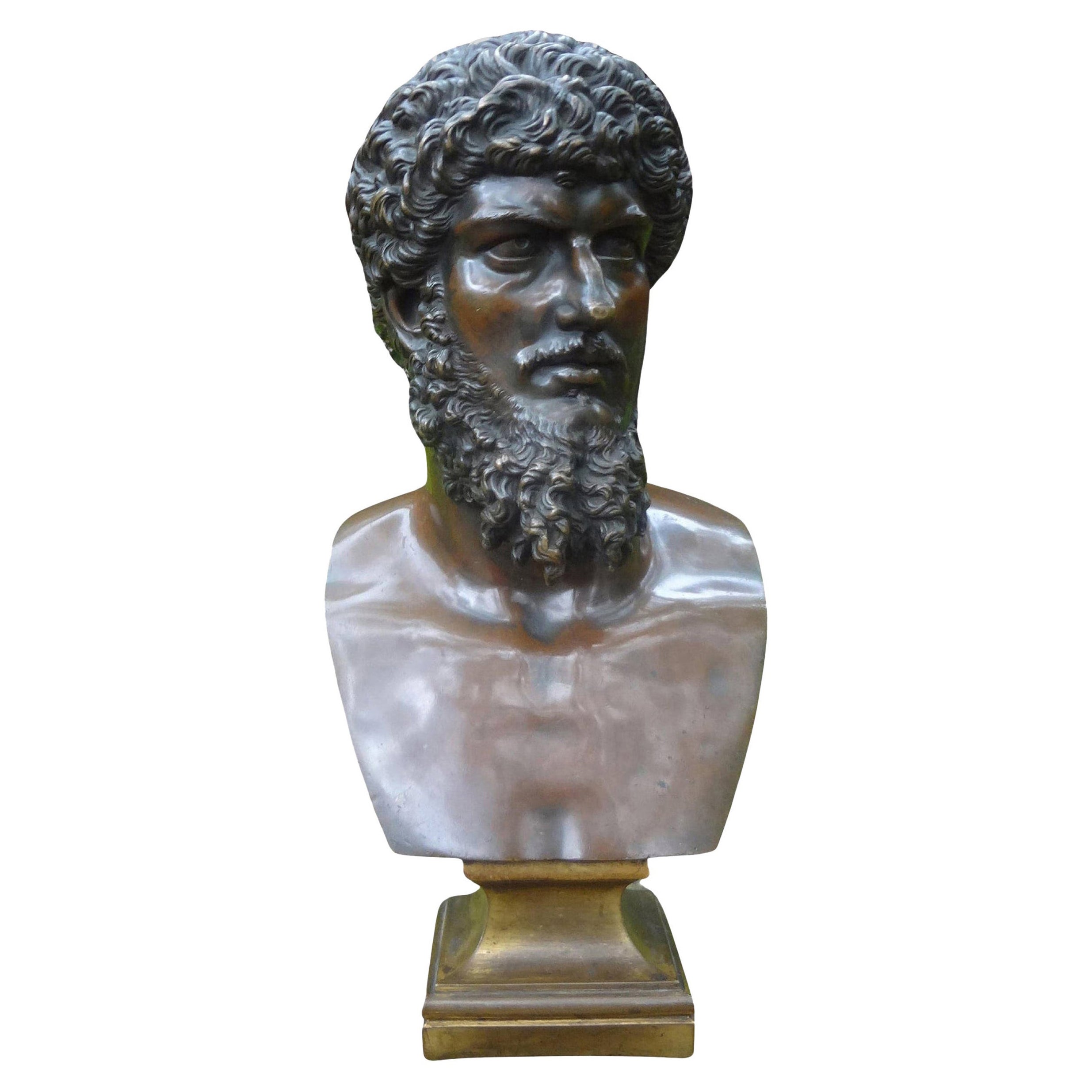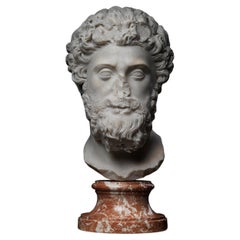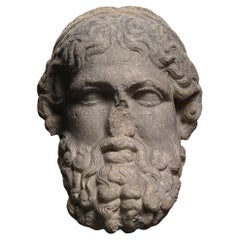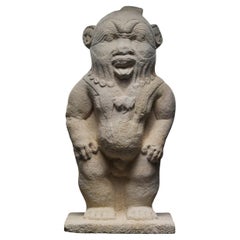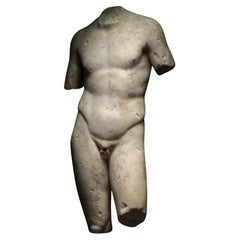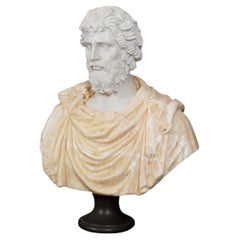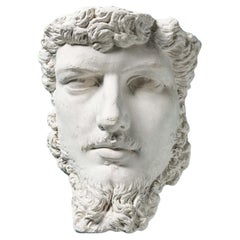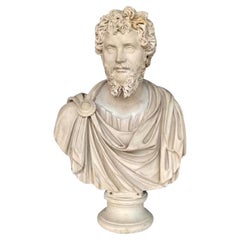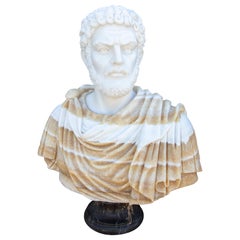Items Similar to Ancient Marble Portrait Bust of a Bearded Man possibly Lucius Verus
Want more images or videos?
Request additional images or videos from the seller
1 of 6
Ancient Marble Portrait Bust of a Bearded Man possibly Lucius Verus
$273,693.57
£199,100
€233,178.71
CA$382,254.13
A$414,563.66
CHF 217,744.59
MX$5,035,605.94
NOK 2,724,729
SEK 2,565,484.50
DKK 1,740,840.29
About the Item
This impressive bust is depicted with head turned slightly to the right and gaze lifted. His eyes are articulated, with the pupils indicated with a drill, giving the face a striking realism. The shoulders are draped with a cloak. Straight brows sit beneath a mass of thickly curling hair, which continues to a full beard. It is worked with great skill, evident in the heavy drill work articulating and highlighting the voluminous curls, and the highly polished surfaces, giving the appearance of soft skin. The contrast between these textures gives a chiaroscuro affect which is one of the main traits of the best Antonine busts.
Roman marble portraits reached their apotheosis of craftmanship and technique under the Antonine emperors, as is evidenced in this masterful bust. The evolution of the style may be traced back to the emperor Hadrian, who was the first emperor to wear a full beard. The articulation of pupils and iris appears on busts of his lover Antinous, a novelty which continued in later Antonine portraits, such as this one. The features of this bust point to a possible identification of Emperor Lucius Verus, who had only one portrait type during his relatively short reign, identified by Max Wegner and appropriately named the ’Main Type’.
Emperor from 161 to 169, he ruled alongside Marcus Aurelius. Tall, blonde, and good-looking, Verus continued the Antonine tradition of a full beard, although he grew his to the length and breadth of a 'barbarian'. He is said to have taken great pride in his hair and beard, and at times even to have sprinkled gold dust on it to further enhance its golden colour. He was an accomplished public speaker, a poet and enjoyed the company of scholars. He was also an ardent fan of chariot racing, publicly backing the 'Greens', the horse racing faction supported by the plebians of Rome, as well as showing an interest in physical activities such as hunting, wrestling, athletics, and gladiatorial combat. Verus fell ill towards the end of 168 while returning from an expedition to the Danube frontier, dying a few days into 169. Marcus Aurelius buried him alongside their adoptive father Antoninus Pius in the Mausoleum of Hadrian, Rome.
Whilst this bust most closely resembles Lucius Verus of all the Antonine emperors, it could be said to be of late Antonine style, possibly a member of the ruling classes paying homage to the emperor by commissioning a bust in the Imperial style.
Condition
The nose was originally restored in the 19th or early 20th century, as evidenced by the techniques and materials used, and also the iron staining from the archaic use of metal pinning. The nose has since been re-restored. Otherwise, in very good state of preservation with natural weathering as expected with age. Mounted on old collection marble base.
Published
Dessins, Tableaux Anciens et Modernes, Céramiques, Archéologie, Objets d’Art et d’Ameublement, Tapisseries, Tapis, Binoche et Giquello, Paris, 9 February 2021, Lot 109.
David Aaron Ltd, 2023, No.12.
Provenance
Previously in a European Private Collection, 19th or early-20th century (based on restoration techniques).
Private Collection of Dr Pierre Calvelli (1921-2015), Aix-les-Bains, France, from at least 1982 (accompanied by customs letter dated 4th June 1982, Switzerland to France), most likely acquired on the Geneva art market.
Thence by descent to his daughters Anne-Claude and Emmanuelle in 2015 (accompanied by French cultural passport 226780).
Sold at: Dessins, Tableaux Anciens et Modernes, Céramiques, Archéologie, Objets d’Art et d’Ameublement, Tapisseries, Tapis, Binoche et Giquello, Paris, 9 February 2021, Lot 109 (1982 document discovered post-sale).
ALR: S00212712, with IADAA Certificate, this item has been checked against the Interpol database.
- Dimensions:Height: 22.84 in (58 cm)Width: 19.69 in (50 cm)Depth: 9.06 in (23 cm)
- Materials and Techniques:
- Period:
- Date of Manufacture:circa 161-169 A.D
- Condition:Repaired. The nose was originally restored in the 19th or early 20th century, as evidenced by the techniques and materials used, and also the iron staining from the archaic use of metal pinning. The nose has since been re-restored. Otherwise, in very good stat.
- Seller Location:London, GB
- Reference Number:Seller: D38151stDibs: LU5517228047952
About the Seller
5.0
Vetted Professional Seller
Every seller passes strict standards for authenticity and reliability
Established in 1910
1stDibs seller since 2020
- ShippingRetrieving quote...Shipping from: London, United Kingdom
- Return Policy
Authenticity Guarantee
In the unlikely event there’s an issue with an item’s authenticity, contact us within 1 year for a full refund. DetailsMoney-Back Guarantee
If your item is not as described, is damaged in transit, or does not arrive, contact us within 7 days for a full refund. Details24-Hour Cancellation
You have a 24-hour grace period in which to reconsider your purchase, with no questions asked.Vetted Professional Sellers
Our world-class sellers must adhere to strict standards for service and quality, maintaining the integrity of our listings.Price-Match Guarantee
If you find that a seller listed the same item for a lower price elsewhere, we’ll match it.Trusted Global Delivery
Our best-in-class carrier network provides specialized shipping options worldwide, including custom delivery.More From This Seller
View AllPortrait Head of Emperor Marcus Aurelius
Located in London, GB
A marble portrait head of the Roman emperor Marcus Aurelius (r. 161-180 A.D.), in his fourth and final portrait type. Known as the Capitoline Imperatori 38 type, after the most famou...
Category
Antique 15th Century and Earlier European Classical Roman Antiquities
Materials
Marble
Marble Head of Hermes
Located in London, GB
Roman head of the god Hermes in an archaising style, following a Greek model from the fourth century B.C.. Hermes is depicted in manner typically found on herms, with a full beard of...
Category
Antique 15th Century and Earlier European Classical Roman Antiquities
Materials
Marble
$69,901
Limestone Statue of Bes
Located in London, GB
A large freestanding statue of the ancient Egyptian god Bes in his canonical form as a stocky dwarf. His face is highly expressive, with large, teardrop-shaped eyebrows drawn into an...
Category
Antique 15th Century and Earlier Egyptian Egyptian Antiquities
Materials
Limestone
$96,913
Torso of a Youth
Located in London, GB
A marble statue of a youth in contrapposto position. The torso is idealised but has only softly suggested muscles, giving the impression of youth. The beginnings of the slender arms ...
Category
Antique 15th Century and Earlier European Antiquities
Materials
Marble
$418,311
Corsican Bronze Hoard
Located in London, GB
Dagger L: 27.8 cm,
Luniform bronze, possibly a belt buckle L: 10.8 cm,
Shield-shaped bronze with a point Diam: 6.5 cm,
Pommel Diam: 3.7 cm,
Violin-bow brooch L: 17.5 cm,
P-Shape...
Category
Antique 15th Century and Earlier European Classical Roman Antiquities
Materials
Bronze
$89,077 / set
A Sardinian Figure of a Warrior
Located in London, GB
An exceptionally rare and important Sardinian bronze figure of a warrior. The highly stylized figure is depicted standing, holding a club resting on his shoulder in the right hand an...
Category
Antique 15th Century and Earlier Italian Antiquities
Materials
Bronze
$188,327
You May Also Like
Early 20th Century Roman Emperor Septimius Severus Multicolor Marble Bust
Located in Los Angeles, CA
A finely crafted multicolor marble bust of Roman Emperor Septimius Severus, representing the refined artistry of classical Roman portraiture. The emp...
Category
Early 20th Century Italian Busts
Materials
Marble
Plaster Wall Hanging Bust of Lucius Verus After the Antique
Located in Wormelow, Herefordshire
A dramatic early 20th century Grand Tour style plaster wall hanging bust of Lucius Verus, co-emperor of ancient Rome from 161-169 alongside his adoptive brother, Marcus Aurelius.
Af...
Category
Early 20th Century Italian Neoclassical Busts
Materials
Plaster
Vintage Grand Tour Resin Bust of Septimus Severus
Located in West Palm Beach, FL
Evoke the classical grandeur of ancient Rome with this striking vintage bust of the Emperor Septimus Severus. Inspired by the tradition of the Grand Tour, this piece captures the int...
Category
Mid-20th Century Italian Neoclassical Busts
Materials
Resin
$1,960 Sale Price
20% Off
Hand-Carved Marble & Onyx Bust of Marcus Aurelius on Base
Located in Marbella, ES
Hand-Carved Marble & Onyx Bust of Marcus Aurelius on Base
Category
Late 20th Century European Busts
Materials
Marble
19th Century French Bronze Bust Sculpture of Emperor Lucius Verus.
By F. Barbedienne Foundry, Ferdinand Barbedienne
Located in Houston, TX
19th century French bronze bust sculpture of Emperor Lucius Varus . This handsome Grand Tour bronze bust of is in the manner of F. Bard...
Category
Antique 19th Century French Greco Roman Busts
Materials
Bronze
19th Century Grand Tour Patinated Bronze Bust of Lucius Verus
Located in Stamford, CT
A 19th century grand Tour patinated bronze bust of Lucious Verus.
Category
Antique 19th Century European Busts
Materials
Bronze
